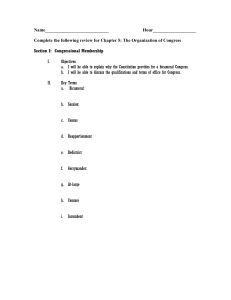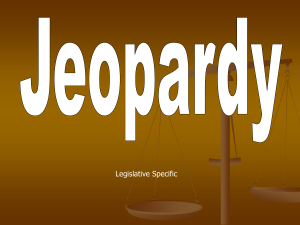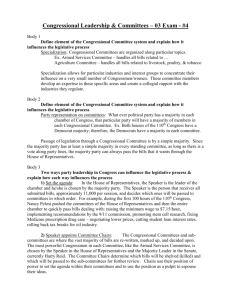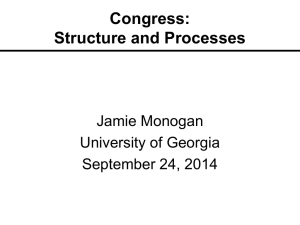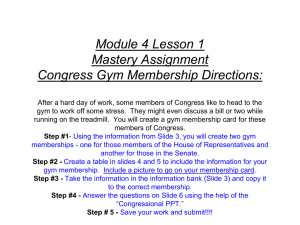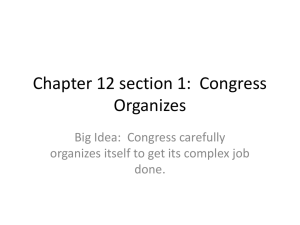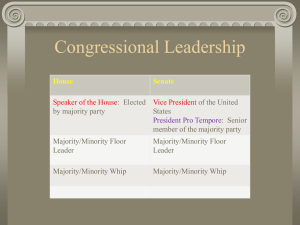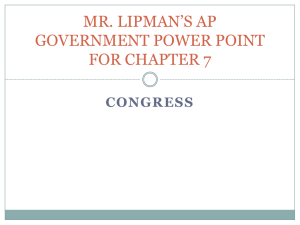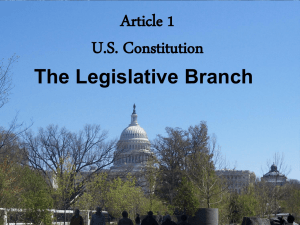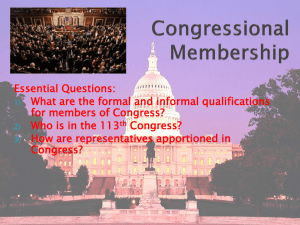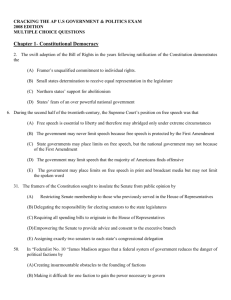Name per
advertisement
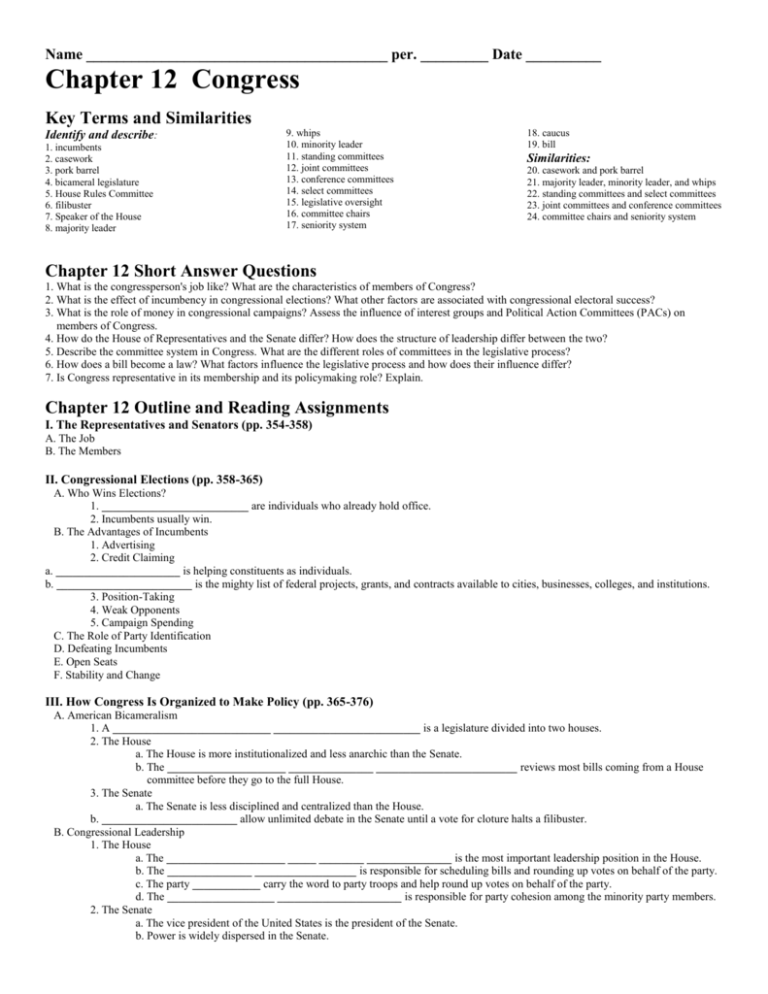
Name ________________________________________ per. _________ Date __________ Chapter 12 Congress Key Terms and Similarities Identify and describe: 1. incumbents 2. casework 3. pork barrel 4. bicameral legislature 5. House Rules Committee 6. filibuster 7. Speaker of the House 8. majority leader 9. whips 10. minority leader 11. standing committees 12. joint committees 13. conference committees 14. select committees 15. legislative oversight 16. committee chairs 17. seniority system 18. caucus 19. bill Similarities: 20. casework and pork barrel 21. majority leader, minority leader, and whips 22. standing committees and select committees 23. joint committees and conference committees 24. committee chairs and seniority system Chapter 12 Short Answer Questions 1. What is the congressperson's job like? What are the characteristics of members of Congress? 2. What is the effect of incumbency in congressional elections? What other factors are associated with congressional electoral success? 3. What is the role of money in congressional campaigns? Assess the influence of interest groups and Political Action Committees (PACs) on members of Congress. 4. How do the House of Representatives and the Senate differ? How does the structure of leadership differ between the two? 5. Describe the committee system in Congress. What are the different roles of committees in the legislative process? 6. How does a bill become a law? What factors influence the legislative process and how does their influence differ? 7. Is Congress representative in its membership and its policymaking role? Explain. Chapter 12 Outline and Reading Assignments I. The Representatives and Senators (pp. 354-358) A. The Job B. The Members II. Congressional Elections (pp. 358-365) A. Who Wins Elections? 1. __________________________ are individuals who already hold office. 2. Incumbents usually win. B. The Advantages of Incumbents 1. Advertising 2. Credit Claiming a. ______________________ is helping constituents as individuals. b. ________________________ is the mighty list of federal projects, grants, and contracts available to cities, businesses, colleges, and institutions. 3. Position-Taking 4. Weak Opponents 5. Campaign Spending C. The Role of Party Identification D. Defeating Incumbents E. Open Seats F. Stability and Change III. How Congress Is Organized to Make Policy (pp. 365-376) A. American Bicameralism 1. A ____________________________ __________________________ is a legislature divided into two houses. 2. The House a. The House is more institutionalized and less anarchic than the Senate. b. The _____________________ _______________ _________________________ reviews most bills coming from a House committee before they go to the full House. 3. The Senate a. The Senate is less disciplined and centralized than the House. b. ________________________ allow unlimited debate in the Senate until a vote for cloture halts a filibuster. B. Congressional Leadership 1. The House a. The _____________________ _____ ________ _______________ is the most important leadership position in the House. b. The _______________ __________________ is responsible for scheduling bills and rounding up votes on behalf of the party. c. The party ____________ carry the word to party troops and help round up votes on behalf of the party. d. The ___________________ ______________________ is responsible for party cohesion among the minority party members. 2. The Senate a. The vice president of the United States is the president of the Senate. b. Power is widely dispersed in the Senate. 3. Congressional Leadership in Perspective C. The Committees and Subcommittees 1. Types of committees a. ___________________________ ______________________ are formed to handle bills in different policy areas. b. _____________ ______________________ exist in a few policy areas and are composed of both House and Senate members. c. _______________________ ______________ are formed when the Senate and House pass a particular bill in different forms. d. ____________________ ________________________ are appointed for a specific purpose. 2. The Committees at Work: Legislation and Oversight a. All bills go though a committee that has considerable power over the fate of the bill. b. _____________________ _________________ is the process of monitoring the bureaucracy and its administration of policy. 3. Getting on a Committee 4. Getting Ahead on the Committee: Chairs and the Seniority System a. ______________________ __________________ are the most important influencers of the committee agenda. b. The ____________________ _____________________ is the general rule for selecting chairs, but there are exceptions. D. Caucuses: The Informal Organization of Congress 1. A ______________________ is a grouping of members of Congress who share some interest or characteristic. 2. The explosion of caucuses has made the representation of interests in Congress a more direct process. E. Congressional Staff 1. Personal Staff 2. Committee Staff 3. Staff Agencies (Congressional Research Service, General Accounting Office, and Congressional Budget Office) IV. The Congressional Process (pp. 376-383) A. Introduction 1. A ________________ is a proposed law, drafted in precise, legal language. 2. Congress has many rules and procedures for passing bills. B. Presidents and Congress: Partners and Protagonists 1. The president is often called the chief legislator. 2. Presidential leadership in Congress is at the margins as a facilitator. C. Party, Constituency, and Ideology 1. Party Influence 2. Constituency versus Ideology D. Lobbyists and Interest Groups V. Understanding Congress (pp. 383-386) A. Congress and Democracy 1. Representativeness versus Effectiveness B. Congress and the Scope of Government VI. Summary (pp. 386-387)
